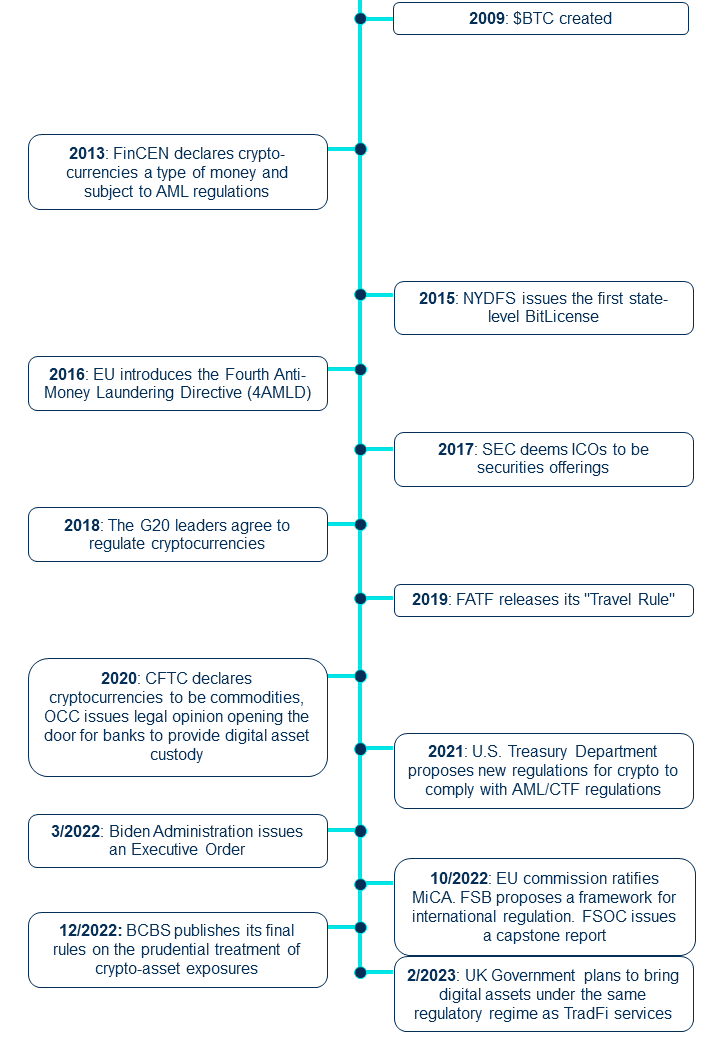Our Blog and Media Coverage

Regulation is Coming to Digital Assets
- Articles

Part 1 – Regulatory milestones
Cryptocurrencies have been one of the most significant technological advancements of the past decade. Many of the early adopters were drawn to the idea of a decentralized financial system that operates outside the traditional banking sector and offers greater anonymity. Some were looking for greater control over their money, others a way to make transactions without revealing their identity.
The early days of cryptocurrencies were characterized by a sense of excitement and in many countries, regulators anxiously watched the market develop. However, over time the use of cryptocurrencies has grown more widespread. In fact according to Chainalysis, at the beginning of 2022, crypto adoption stood at 295M, just under 4% of the global population.
Unfortunately, the events of 2022 will likely go down in history as the tipping point for the industry. What began as a slightly slipping valuation at the end of 2021, became a full-fledged landslide. Then the market went from bad to worse: 1) May – the Terra Luna scandal and the de-peg of USD/UST caused a significant loss of market cap in the industry; 2) June – trading and venture capital firms that were overextended filed for liquidation or bankruptcy. 3) In November, FTX, one of the world’s largest exchanges, filed for bankruptcy causing a ripple effect whose outcomes remain to be seen.
It is clearer than ever that regulators need to step into the void and become more proactive in their legislation. Even industry stalwarts, such as Coinbase CEO Brian Armstrong and Binance CEO, Zhao (CZ), agree. According to Laura Talvitie, Senior Manager, Digital Assets Regulation, PwC UK: “Cryptocurrencies may have been originally created to operate free from control, but the lack of a robust global regulatory framework for digital assets is harmful to the sector, innovation, and consumer protection.”
Regulation has evolved with the industry
The regulatory landscape has evolved in line with the industry. It is clearer than ever that what began as a nascent, relatively marginal form of payment has become more interconnected with the traditional financial ecosystem, and has an increasing impact on financial stability. Here is a brief overview of some milestones in the regulation of cryptocurrencies:
2009: Bitcoin is created.
2013: The U.S. Financial Crimes Enforcement Network (FinCEN) releases guidelines stating that cryptocurrencies are considered a type of money and subject to AML (anti-money laundering) regulations.
2015: The New York State Department of Financial Services (NYDFS) issues the first state-level BitLicense, requiring companies dealing in cryptocurrencies to meet certain regulatory standards.
2016: The EU introduces the Fourth Anti-Money Laundering Directive (4AMLD), which requires cryptocurrency exchanges to comply with anti-money laundering regulations.
2017: Initial Coin Offerings (ICOs) become popular and attract regulatory attention. The SEC starts to take enforcement action against ICOs that it deems to be securities offerings.
2018: The G20 leaders agree to regulate cryptocurrencies to prevent their use for illegal activities.
2019: The Financial Action Task Force (FATF), an international organization focused on combating money laundering, releases its “Travel Rule” guidance, which requires virtual asset service providers (VASPs) to share information about cryptocurrency transactions.
2020: The U.S. Commodity Futures Trading Commission (CFTC) declares cryptocurrencies to be commodities and regulates them as such. The Office of the Comptroller (OCC) issues legal opinions opening the door for banks to provide custody of digital assets.
2021: The U.S. Treasury Department proposes new regulations to require cryptocurrency exchanges to comply with anti-money laundering and counter-terrorism financing regulations.
3/2022: Biden Administration issues an Executive Order, outlining a whole-of-government approach addressing risks stemming from the growth of digital assets and blockchain technology.
10/2022: EU commission ratifies MiCA (Market in Crypto-Assets) regulation which is the world’s first cross-jurisdictional regulatory and supervisory framework for digital assets. However, it is not expected to come into full force before 2024. Financial Stability Board (FSB) publishes a proposed framework for international regulation of digital assets and stablecoin arrangements. FSOC (Financial Stability Oversight Committee) issues a capstone report concluding that (indeed) there is no comprehensive regulatory framework in the US.
12/2022: Basel Committee on Banking Supervision (BCBS) published its final rules on the prudential treatment of crypto-asset exposures.
2/2023: The UK Government floats plans to bring digital assets under the same regulatory regime as traditional financial services. Including e strengthening rules for crypto trading platforms, a ‘robust’ regime for crypto lending, and a tightening of the rules around financial intermediaries and custodians.
In summary
The cryptocurrency revolution is upon us, and it’s bringing with it a wave of change that is challenging traditional financial systems and upending the status quo. As the crypto industry continues to evolve, the need for regulation is becoming increasingly apparent. But what form will these regulations take and what impact will they have on the crypto landscape? The answers to these questions will shape the future of this industry.
Moreover, it is likely that as additional requirements will continue to evolve, these will require even more flexibility and versatility in the way institutions safeguard their digital assets and how custodians manage the funds on behalf of clients. Institutions, whether choosing self-custody or working through a custodian, should keep in mind that the new regulations will have important implications for the business.
The next post in this series will zoom in on the US, and discuss some of the latest developments there.
Would you like to understand the implications of the new regulations on your custody solution? Learn more about GK8’s custody solution, and how our regulatory-ready solutions and policy engine capabilities future-proof your custody infrastructure for the long haul.
For more information, click here.





